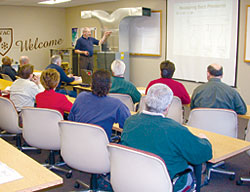
The most effective way to invest in a technician is not just training, but quality training. As such, training is a partnership in the success of any HVACR contractor. There should be expectations from both the people providing and attending the training. That is the approach and mindset of the staff at the HVAC Training Center in Omaha, Neb.
The need for consistent improvement in technical competency is ongoing, and the HVAC Training Center in Omaha is a facility where technicians can hone those skills. In the areas of residential and light commercial, the training center has been providing HVAC-related training to hundreds of technicians in Omaha for the past 12 years. Now, an expanded range of programs is offered in a broader geographic area within the Midwest.
The training center is affiliated with the Omaha Public Power District (OPPD). According to HVAC Training Center administrator and instructor, Dave Swett, the center has expanded its training at the right time.
"With the addition of NATE [North American Technician Excellence] testing, the training center has decided to expand outside of its normal service area," Swett said. "Training has been added to provide a broader representation of the technology that is available."
The training is only available to experienced techs - no entry-level training. Swett said the techs are qualified by a competency exam. He doesn't like to use the word "test," as he believes it has a negative connotation. The exams are called "knowledge reviews."
A knowledge review is given at the beginning and end of each course. This allows the technicians to understand where they have gained knowledge and what the next step in training will be to continue honing their skills.
"The training center courses are designed for the technician or installer with at least one to two years of experience, or for the technician that has been in the industry for several years and has a desire to improve their diagnostic and service skills," he said. "We want to build on what they have learned on the job."
"Our programs are designed to improve competency within the industry; and NATE gives credit to technicians who are already certified for taking technical programs that are aligned with the NATE KATEs [Knowledge Areas of Technician Expertise]," he said.
Enrollment and interest in the training has increased.
"We've had a fairly significant increase in our enrollment in the last year because we have just started to do some marketing outside of our territory," Swett said. "The interest locally has been good for the last couple of years, primarily because we have expanded our source offerings."

Total Systems Approach
A total systems approach makes the training center unique. The courses focus on using the HVAC technician's disciplines and skills, combining them into a single approach to service and maintenance. Learning to tie electrical, air distribution, and refrigeration lessons together leads to a key result - an effective framework needed for the technician to excel.It is impossible to deliver customer comfort without delivering equipment, performance, and efficiency. Techs learn how to do it right the first time.
A significant percentage of HVAC technicians have a very limited knowledge of physics and theory and how that is applied in their profession. Physics and theory can be intimidating words, but in reality it is the practical way of application. The technician must make sense of why a piece of equipment failed and how to fix it, not using trial and error or "rule of thumb."
A strong visual basis for learning is used at the training center. Learning visually has proved to be an effective method for retaining knowledge. "We changed our format to high-visual, more computer-based," Swett said. "People learn best through pictures. A picture is worth a thousand words."
The training programs help the technician to completely understand the HVAC equipment by improving basic competencies and skill sets. Having basic knowledge is important when technicians need training with unique aspects of specific manufacturers' equipment.
"We've designed our programs by asking what the HVAC industry wants or needs through our training interest form. We continually watch technological, marketing, and political forces that drive our industry," Swett said.
"I've been in the industry for 26 years. The problems we had in our industry when I first started were in the areas of electrical theory, refrigeration theory, and air distribution theory. Fast forward 25 years and the problems still exist. Our training formats are not as effective as they could be. That's what we are trying to change with this approach."
The training center has maintained a close relationship with local contractors.
"We want to provide value to the contractors in terms of the time and money that they have invested in training," Swett stated. "Every program that we have developed since I have been here has been with feedback from the local contractors.
"We surveyed the local contractors and technicians and asked them what they needed from a beginning level of competency to an advanced level."
For more information, visit www.hvacsystemtraining.com or call 877-758-5500.
Publication date: 05/16/2005

Report Abusive Comment